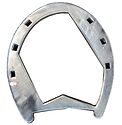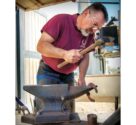Advertise Follow Us
American Farriers Journal

View Archived Issues
May/June 2021
Volume: 47
Edition: 4
American Farriers Journal is the “hands-on” magazine for professional farriers, equine veterinarians and horse care product and service buyers.
-
Table Of Contents
Table Of Contents
Farrier Professionalism is Improving
An increased emphasis on education and communication in the industry are listed among top reasons for the improved attitudes about hoof-care professionalsRead MoreShoeing For A LivingArizona Farrier Rises to Dry-Heat Hoof-Care Challenges
A sharp knife and a sharper mind are among the tools used by Shaun Woodsum in his farriers businessRead MoreThere’s More to Toe Length than Meets the Eye
Toe length is relative to each horse and many factors should be considered for what is best for a particular horseRead MoreEvidence-Based Prevention of Laminitis in a Clinical Setting
University of Pennsylvania veterinarian and researcher Andrew van Eps shares what works in laminitis prevention, of which our understanding will changeRead MoreHow to Achieve the Benefits of a Frog Support Horseshoe
Intermediate to skilled farriers are well-positioned in therapeutic casesRead MoreFarriers Should Not Sedate Clients’ Horses
An improper injection can lead to significant medical and legal liabilitiesRead MoreLearn Where Your Forging Motivation Comes From
Identifying what encourages you to improve will help you accomplish your goalsRead MoreSet the Horse and Farrier Up for Success
Ohio shoer has a system for picking up the front foot that puts a horse at ease and increases efficiencyRead MoreBadass Rigs & TrailersFarrier’s Trailer Built by FFA Students
Texas horseshoer Don Mock hauls a slick, functional trailer that was built by teenage brothers as a school projectRead MoreResearch Journal: May/June 2021
The information, ideas and opinions expressed are those of the author and do not necessarily represent those of the United States Department of Agriculture.Read More -
Featured Articles
Featured Articles
Badass Rigs & TrailersFarrier’s Trailer Built by FFA Students
Texas horseshoer Don Mock hauls a slick, functional trailer that was built by teenage brothers as a school projectRead MoreHow to Achieve the Benefits of a Frog Support Horseshoe
Intermediate to skilled farriers are well-positioned in therapeutic casesRead MoreShoeing For A LivingArizona Farrier Rises to Dry-Heat Hoof-Care Challenges
A sharp knife and a sharper mind are among the tools used by Shaun Woodsum in his farriers businessRead More - Digital Edition
-
Online Extras
Online Extras
















